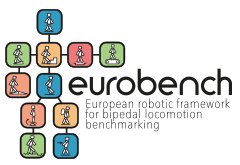
Thanks to the EU-funded EUROBENCH Project, prosthetics and exoskeletons are currently being tested at the wearable robots facilities at the Hospital Los Madroños (HLM), in Madrid, and humanoid robots at the Italian Institute of Technology (ITT), in Genoa.
At the Hospital Los Madroños, exoskeletons can be tested under several conditions, including stair negotiating, balancing on unstable surfaces, and walking over irregular terrain. So far, the tests have mainly been conducted on healthy subjects. However, the same facility will serve as a neuromechanics lab of the recently created “Center for Clinical Neuroscience (CCN)”, whose aim will be to use the know-how retrieved from the EUROBENCH project to study and improve the technology-assisted rehabilitation processes of neurological-impaired individuals.
These facilities have been built thanks to the collaboration of numerous third parties that have received funding from EUROBENCH to develop different testbeds, experimental protocols and metrics for evaluating and comparing the performance of robotics systems during locomotion. A total of 17 sub-projects were funded for the development of the facilities.

Most of the testbeds developed within the framework of the sub-projects have been already integrated into the wearable robots facilities at the Hospital Los Madroños. The list includes:
– BENCH, created by the University of Stuttgart, University College Dublin, and the University of Rome III. BENCH is a sensorized chair for the study of kinematics while seated and standing.
– StepByStep, developed by the CEIT, CNR and University of Bologna. StepByStep is a sensorized and motorized staircase for studying kinematics and muscular activity.
– BeStable, developed by Delft University, University Rehabilitation Institute Ljubljana, and Motek. BeStable is a sensorized treadmill for studying spatiotemporal parameters during perturbed and unperturbed walking.
– Experience, developed by the University Campus Biomedico of Rome. Experience is a physiological sensors and subjective questionnaire to measure user experiences while walking with exoskeletons
– Bullet, developed by the University of Brescia, the University of Trento University and the University of Genoa. Bullet is a sensorized crutches to study the effect of walking with an exoskeleton on body dynamics.
– Beat, developed by Tuscia University and The Niccolò Cusano University. Beat is a mobile platform for studying stability.
– Standing during manipulation, developed by the Cajal Institute of CSIC. Standing during manipulation is a mobile shelf to study muscular fatigue during weightlifting.
– 4-in-1, developed by the Cajal Institute of CSIC. 4-in-1 is a versatile platform that allows walking overground on slopes and irregular terrains.
– Benchbalance, developed by the Robotics and Automation Centre from CSIC, the University of Twente, and the University Campus Biomedico of Rome. Benchbalance is a portable perturbing device to study the balance capabilities of exoskeletons by means of controlled perturbations.
– PEPATO, developed by the Santa Lucia Foundation. PEPATO is a software to analyse muscle synergies during walking.

In a second phase of the EUROBENCH project, the consortium opened another open call to fund 40 sub-projects whose objective was to test robots using the EUROBENCH facilities (in situ or remotely) and analyze the results. In this context, more than 100 people from more than 25 research groups and companies have visited the EUROBENCH facilities in Madrid and Genoa to test and benchmark their robotic devices since September 2021. The subprojects that have physically attended the facilities are the following:
– FEAT – Functional Ergonomic and neuro-muscular Assessment of TWIN-Acta exoskeleton
– Auxivo AG – EUROBENCH Framework Validation for Industrial Exoskeletons
– S@EB – Sweaty@EUROBENCH
– NOP2XBENCH – Benchmarking the Humanoid Open Platform NimbRo-OP2X
– EXOSMOOTH – Test of innovative EXOskeleton control for SMOOTH assistance, with and without ankle actuation
– AssistControl-H3 – Performance Assessment of Model-Based Assistance Controllers of Lower Limb Exoskeletons: Exo-H3 Case Study
– HUMATRAN – Bioinspired balance of HUMAnoid robots for TRANsport tasks
– BELK – Biomechanical Assessment of BELK exoskeleton in different benchmarking scenarios
– SLEDGE – Shoulder Loads in Exoskeleton-assisted Daily life Gestures
– AXBAP Project – Axiles Bionics Alpha-Pilot Project
– TO RANK – Testing and Optimization of a Robotic ANKle
– NeuroGait – Assistive locomotion based on non-invasive real-time neural interfacing
– Adaptive –KO – Adaptive – Knee Orthosis
– XSPINE – Exoskeleton Support in Industrial Operations
– TestABLE – TESTing the performance of the ABLE exoskeleton in several Eurobench scenarios
– WALKBENCH – Benchmarking walking and balancing for humanoid robots
– DECODED – Decoding brain activity related to gait during exoskeleton-assisted walking
– CosmoRob – Combining Sensor-based Motion Tracking with Wearable Robotics for Empowering the Validation of Robotic Technologies
– NEXT – Neurorehabilitation EXoskeleton Test
– PROPELLING – Pushing forward robot development for lawmaking 1
– INTENTION – Improving Human-Robot Interaction through EMG-Onset Controller for Lower Limb Exoskeletons
– HumaBeliefs – Benchmarking Humanoid Belief Space Locomotion Planning
– PELLEXER – Performance Evaluation of Lower Limb Exoskeletons for Emergency Response Forces
– New Balance Pis – Novel Performance Indicators for the Characterization of Balance Capabilities in Generic Biped Systems and during Various Tasks
– AUT-STR-1 – Investigation on control strategies for assisting hemiplegic users in daily mobility

